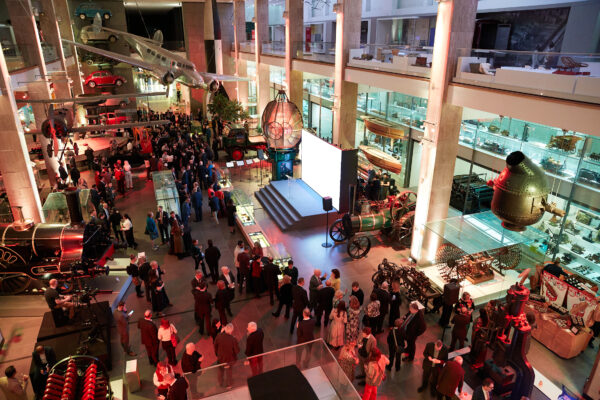The Science Museum in London, UK, has opened Energy Revolution: The Adani Green Energy Gallery, a new free gallery which explores how the world can generate and use energy more sustainably to urgently decarbonise and limit climate change.
Through displays of contemporary and historic objects from the UK and abroad, interactive digital exhibits, and specially commissioned models, the gallery shows how the past, present and future are shaped by human imagination and innovation and explores how everyone has a role to play in deciding the world’s energy future.
Adani Green Energy Ltd (AGEL), the gallery’s title sponsor, is the world’s leading solar power developer and India’s largest renewable energy company that develops, owns, and operates utility scale grid-connected solar, wind and hybrid renewable power plants. With a locked-in growth trajectory up to 21.8 GW, it currently has an operating renewable portfolio of over 9.5 GW spread across 12 states in India, including the world’s largest wind-solar hybrid power cluster of 2,140 MW in Jaisalmer, Rajasthan. The company targets 45 GW of installed renewable energy capacity by 2030, which is equivalent to providing clean energy to almost every house in England.
At Khavda, is in the Indian state of Gujarat, Adani Green Energy is building the world’s largest renewable energy park with a generation capacity of 30 GW. The park spans an area of 538 square kilometers, which is more than five times bigger than Paris.

AGEL
Sagar Adani, executive director, AGEL, said, “There is no greater resource in the fight against climate change than education. Through the sponsorship of the [Energy Revolution gallery at London Science Museum], we aim to inspire young minds, scientists and innovators to imagine a future powered by clean energy and build a carbon-free world. It is an initiative to stimulate their interest, curiosity and awareness, and encourage their active participation in creating clean technologies. The gallery brings together the global community to enable the shift towards energy efficiency, clean energy adoption and carbon emissions reduction.”
The Energy Revolution gallery at London Science Museum examines this century’s defining challenge through the lens of imagination across three sections. In ‘Future Planet,’ visitors can explore how scientists use complex computer-based models to understand Earth and what these tell about the range of climate futures that might lie ahead.
In ‘Future Energy,’ technologies – and the people behind them – that are reimagining how energy is supplied and used are highlighted alongside historic artefacts which provide a longer view of the transition away from fossil fuels.
‘Our Future’ looks to a new world that is being dreamt up, with children’s creative ideas of how the world will meet its future energy needs displayed with expert responses to them.
At the centre of the gallery is ‘Only Breath,’ a moving sculpture that signifies the power of nature to inspire technological change. Radiating outward from the centre are plinths which display vital low-carbon renewable energy technologies for the transition, from nuclear, hydrogen and solar to wind and tidal power, alongside historic innovations. Objects in this section include a 7m long tidal turbine blade made by Scottish renewable energy company Orbital Marine Power and the first electric taxi, the Bersey cab, hailed by Londoners in 1897.
The challenges of electrification, energy storage, and supply and demand are also explored, with visitors invited to play interactive games and use models that show how energy can be generated and distributed. Possible routes to low-carbon transport, as well decarbonisation of buildings and construction industries, are featured. Visitors can learn about climate modelling and see instruments used to measure climate.
Energy Revolution was designed by award-winning architects, Unknown Works. A key element of sustainable design was the reuse of redundant shelves from the Science Museum’s former object store. The gallery’s carbon footprint has been monitored, and recyclable aluminium was used where possible.
Sir Ian Blatchford, Director and Chief Executive of the Science Museum Group, said, “In a week when we’re celebrating a record 2.25 million visits by UK residents to the museum, including a million children, this stunning gallery offers even more to ignite curiosity among those who will visit in the year ahead – provoking important conversations about the urgent need for the world to generate and use energy more sustainably.”
This content is protected by copyright and may not be reused. If you want to cooperate with us and would like to reuse some of our content, please contact: editors@pv-magazine.com.









1 comment
By submitting this form you agree to pv magazine using your data for the purposes of publishing your comment.
Your personal data will only be disclosed or otherwise transmitted to third parties for the purposes of spam filtering or if this is necessary for technical maintenance of the website. Any other transfer to third parties will not take place unless this is justified on the basis of applicable data protection regulations or if pv magazine is legally obliged to do so.
You may revoke this consent at any time with effect for the future, in which case your personal data will be deleted immediately. Otherwise, your data will be deleted if pv magazine has processed your request or the purpose of data storage is fulfilled.
Further information on data privacy can be found in our Data Protection Policy.